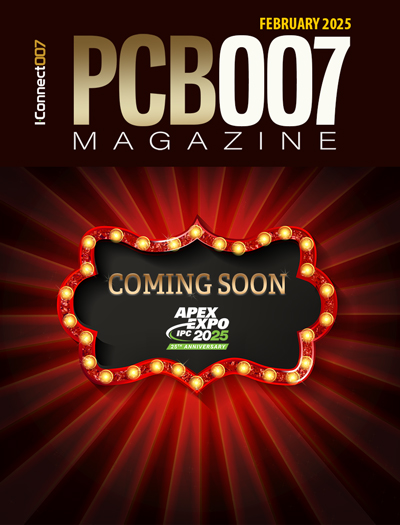-

- News
- Books
Featured Books
- pcb007 Magazine
Latest Issues
Current Issue
The Essential Guide to Surface Finishes
We go back to basics this month with a recount of a little history, and look forward to addressing the many challenges that high density, high frequency, adhesion, SI, and corrosion concerns for harsh environments bring to the fore. We compare and contrast surface finishes by type and application, take a hard look at the many iterations of gold plating, and address palladium as a surface finish.

It's Show Time!
In this month’s issue of PCB007 Magazine we reimagine the possibilities featuring stories all about IPC APEX EXPO 2025—covering what to look forward to, and what you don’t want to miss.

Fueling the Workforce Pipeline
We take a hard look at fueling the workforce pipeline, specifically at the early introduction of manufacturing concepts and business to young people in this issue of PCB007 Magazine.
- Articles
- Columns
Search Console
- Links
- Media kit
||| MENU - pcb007 Magazine
BAE Systems Completes Testing, Ships Primary Instrument for Roman Space Telescope
August 14, 2024 | PRNewswireEstimated reading time: 2 minutes
BAE Systems has successfully shipped the Nancy Grace Roman Space Telescope’s Wide Field Instrument (WFI) to NASA’s Goddard Space Flight Center in Greenbelt, Maryland, signaling the completion of integration and testing of the state-of-the-art instrument.
BAE Systems has successfully shipped the Nancy Grace Roman Space Telescope’s Wide Field Instrument (WFI) to NASA’s Goddard Space Flight Center in Greenbelt, Maryland, signaling the completion of integration and testing of the state-of-the-art instrument.
The WFI is the primary scientific instrument for the Roman Space Telescope, NASA's next flagship astrophysics mission. The instrument is an advanced visible-to-near-infrared imager with additional spectral capabilities that will capture highly detailed images over wide swaths of the sky, offering a field of view at least 100 times greater than its predecessor, the Hubble Space Telescope, with a similar resolution. This instrument will dramatically improve the speed and scale of astronomical surveys, unlocking new insights into the mysteries of dark matter and dark energy, discovering distant galaxies and exoplanets, and studying how the structure of the universe has formed over billions of years.
BAE Systems designed and built the instrument's opto-mechanical assembly, which includes the optical bench, element wheel, thermal control system, alignment compensation mechanism, and associated subsystem control electronics. NASA Goddard build the instrument's focal plane system, relative calibration system, diffraction elements for the element wheel, and the instrument command and data handling electronics. BAE Systems also led the integration of the WFI's components, along with environmental testing to ensure it can withstand the stresses of a launch and the conditions it will face in space.
"The Wide Field Instrument is one of the most sophisticated instruments ever constructed, and once it's on orbit it will provide the scientific community with the most comprehensive surveys of the sky we've ever captured," said Bonnie Patterson, senior director of civil space programs for BAE Systems Space & Mission Systems. "Our team is proud to support such an ambitious mission, and we look forward to seeing what amazing discoveries this instrument will help to make throughout the universe."
With the instrument delivered, the Goddard team will lead the effort to integrate the WFI into the instrument carrier and mate it to the spacecraft bus later this year. The Roman Space Telescope is scheduled to launch by May 2027.
The work on the Roman Space Telescope continues the BAE Systems Space & Mission Systems' legacy of contributing to all of NASA's flagship astrophysics missions, including the James Webb Space Telescope and the Great Observatories: the Hubble Space Telescope, Spitzer Space Telescope, Chandra X-ray Observatory, and the Compton Gamma-Ray Observatory. BAE Systems was also recently selected to conduct a research effort for NASA's planned Habitable Worlds Observatory, called the Ultra-stable Large Telescope Research and Analysis Program – Critical Technologies (ULTRA-CT).
Suggested Items
New Splitting Method: Fraunhofer IIS Brings Satellites Into The 5G Era
04/04/2025 | Fraunhofer IAFGlobal mobile communications that reliably reach every remote region, leaving no gaps on the map? Satellites play a key role in achieving this goal. In the future, however, not all satellites will be powerful enough to act as complete base stations.
Acquisition of MADES Strengthens Cicor's Pan-European Leadership in the Aerospace & Defence Sector
04/03/2025 | CicorCicor Group announces that it has signed an agreement to acquire 100% of the shares of Spanish electronics company Malaga Aerospace, Defense & Electronics Systems S.A.U. (MADES).
Vertical Aerospace Adopts Universal Fast-Charging Standard to Accelerate eVTOL Deployment
04/01/2025 | BUSINESS WIREVertical Aerospace (Vertical), a global aerospace and technology company that is pioneering electric aviation, announces it will adopt the Combined Charging Standard (CCS) for the VX4, joining BETA Technologies and Archer Aviation in driving a universal, fast-charging system for electric vertical take-off and landing (eVTOL) aircraft.
Nokia, Honeywell Aerospace Technologies Partner with Numana to Advance Quantum-safe Networks
04/01/2025 | HoneywellNokia and Honeywell Aerospace Technologies announced a strategic partnership with Numana to advance Quantum-Safe Networks (QSN) in Montreal, Canada, and worldwide.
Molex Releases New Report on Strategies for Advancing Rugged, Reliable Connectivity in Modern Aerospace and Defense Applications
04/01/2025 | MolexMolex, a global electronics leader and connectivity innovator, has released a new report from AirBorn, a Molex company, which explores the unrelenting demands for constant, continuous connectivity to support the rigors of modern aerospace, defense and space-industry applications.


